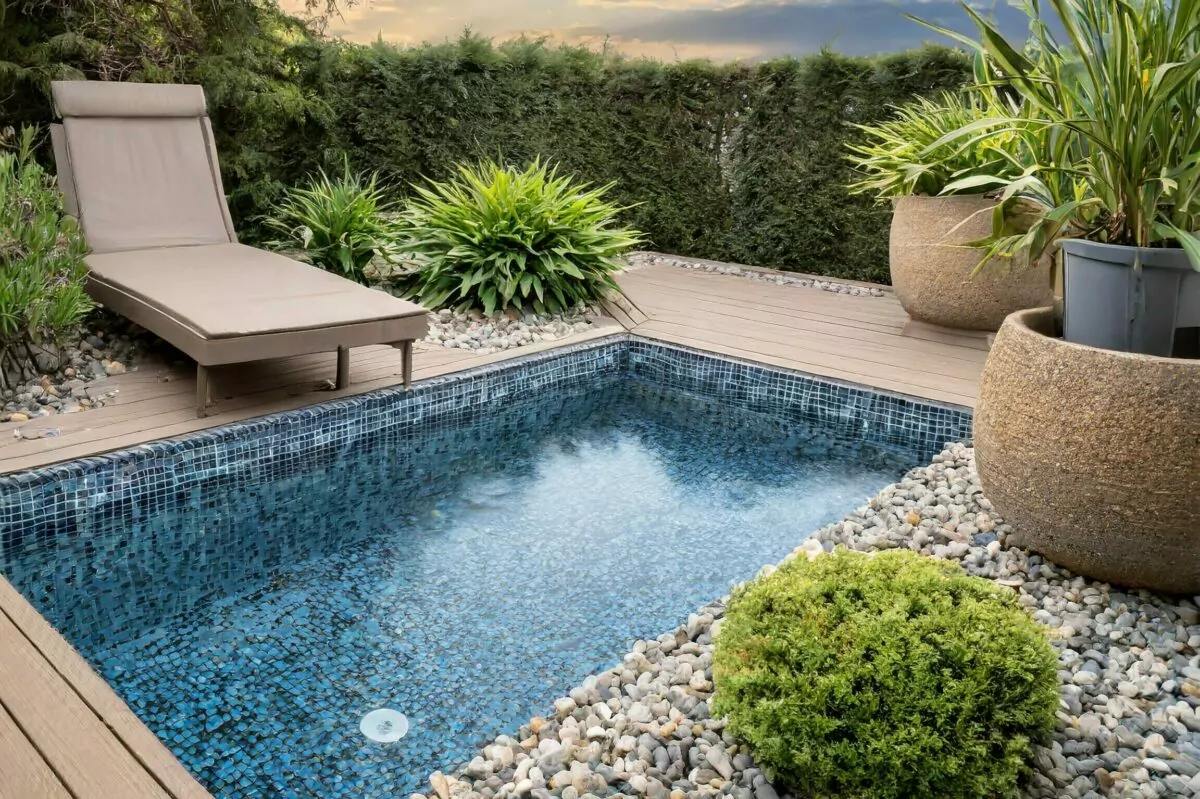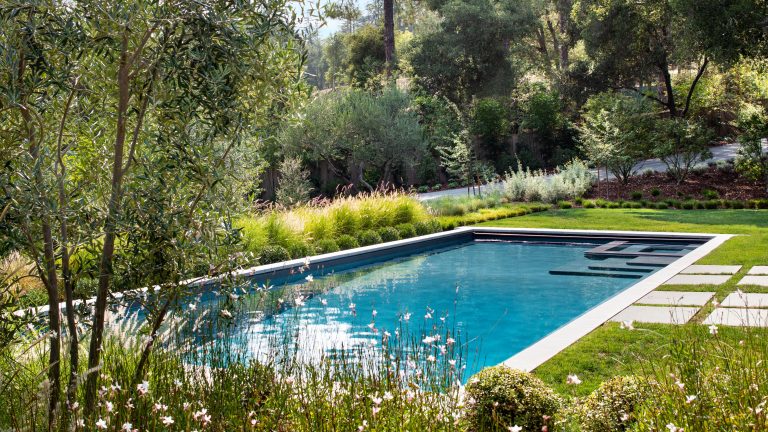Creating the perfect backyard oasis isn’t just about having a stunning pool. It’s also about designing a complementary space that enhances the overall aesthetics and functionality of your outdoor area.
In this blog post, we’ll guide you through the process of paving your backyard to complement your pool, helping you create a cohesive and inviting environment that you’ll love spending time in.
Assessing Your Backyard

Before you start planning your paving project, it’s essential to assess your backyard’s current condition. Evaluating the space, soil, and drainage will help you identify potential challenges and determine the best approach for your paving project.
Evaluating Space and Soil Condition
First, take a thorough look at your backyard space. Measure the area around your pool and consider how much space you want to dedicate to paving. This will help you create a layout that maximises functionality without overcrowding the area.
Next, assess the soil condition. Different soil types can impact the stability and longevity of your pavers. For instance, clay soil can expand and contract with moisture, causing pavers to shift. Sandy soil, on the other hand, may require additional stabilisation to prevent erosion.
Considering the Pool’s Design
Your pool’s design plays a crucial role in determining the best paving approach. Consider the shape, size, and style of your pool, as well as any existing features like waterfalls or landscaping. This will help you choose pavers and layouts that complement the pool’s aesthetics.
Natural Elements and Drainage
Lastly, consider the natural elements in your backyard, such as trees, plants, and slopes. These can impact drainage and affect the overall design. Proper drainage is essential to prevent water from pooling on the surface or seeping into the soil, which can damage pavers over time. Ensure your paving plan includes adequate drainage solutions to protect your investment.
Choosing the Right Pavers
Selecting the right paver materials is crucial for creating a beautiful and durable poolside area. There are several options to choose from, each with its own set of benefits and considerations.
Overview of Paver Materials
Concrete Pavers: Concrete pavers are a popular choice due to their affordability, durability, and versatility. They come in various shapes, sizes, and colours, allowing you to create custom designs that fit your style.
Stone Pavers: Natural stone pavers, such as travertine, limestone, and sandstone, offer a luxurious and timeless look. They are highly durable and can withstand harsh weather conditions. However, they can be more expensive than other options.
Brick Pavers: Brick pavers provide a classic and rustic charm. They are durable and slip-resistant, making them a safe choice for poolside areas. However, they may require more maintenance to prevent moss and algae growth.
Factors to Consider
When selecting pavers, consider factors such as durability, style, and cost. Durability is essential for withstanding the wear and tear of poolside activities, while style should complement your pool and overall backyard design. Finally, consider your budget and choose pavers that offer the best value for your investment.
Design Ideas for Poolside Paving

Once you’ve chosen your pavers, it’s time to think about the design. The right layout and pattern can enhance the aesthetics and functionality of your poolside area.
Popular Paver Patterns and Layouts
Herringbone Pattern: The herringbone pattern is a classic and visually appealing option. It provides a sense of movement and can make smaller spaces appear larger.
Basket Weave Pattern: The basket weave pattern offers a more traditional and timeless look. It’s an excellent choice for adding texture and interest to your poolside area.
Running Bond Pattern: The running bond pattern is a simple and clean design that works well with modern and minimalist styles. It’s also one of the easiest patterns to install, making it ideal for DIY projects.
Creating Zones and Defining Spaces
Pavers can also be used to create distinct zones and define spaces within your backyard. For example, you can use different paver patterns or colours to separate lounging areas from dining spaces. This helps create a more organised and functional layout.
DIY vs. Hiring Professionals
Deciding whether to tackle your paving project yourself or hire local pool builders sydney is a significant consideration. Each approach has its pros and cons, and it’s essential to weigh them carefully.
Pros and Cons of DIY
Pros: DIY projects can save you money on labour costs and give you a sense of accomplishment. You’ll also have complete control over the design and execution of the project.
Cons: Paving can be physically demanding and time-consuming. It requires specific tools and skills, and mistakes can be costly to fix. DIY projects may also take longer to complete, potentially disrupting your backyard for an extended period.
When to Consider Professional Help
If you’re not confident in your paving skills or if the project is particularly complex, hiring professionals may be the best option. Professionals have the experience and expertise to ensure a high-quality and long-lasting result. They can also complete the project more quickly, allowing you to enjoy your new poolside area sooner.
Maintenance and Longevity

Proper maintenance is essential to ensure the longevity of your pavers and keep them looking their best.
Tips for Paver Maintenance
Regular Cleaning: Sweep and wash your pavers regularly to remove dirt, debris, and stains. This helps prevent the buildup of grime and keeps your pavers looking fresh.
Sealant Application: Applying a sealant to your pavers can protect them from stains, weather damage, and fading. Reapply the sealant every few years to maintain its effectiveness.
Weed Control: Keep an eye out for weeds growing between your pavers and remove them promptly. Consider using a weed barrier or polymeric sand to prevent weed growth.
Protecting Pavers from Pool Chemicals and Weather
Pool chemicals can be harsh on pavers, causing them to deteriorate over time. Rinse your pavers with fresh water regularly to remove any chemical residue. Additionally, protect your pavers from extreme weather conditions by covering them during the off-season or using weather-resistant materials.
Conclusion
Paving your backyard to complement your pool is an excellent way to enhance the overall aesthetics and functionality of your outdoor space. By assessing your backyard, choosing the right pavers, and considering thoughtful design ideas, you can create a stunning poolside haven.
Whether you decide to tackle the project yourself or hire professionals, proper maintenance will ensure your pavers remain in top condition for years to come. Now that you have the knowledge and inspiration, it’s time to take action and transform your backyard into a beautiful and inviting oasis.

